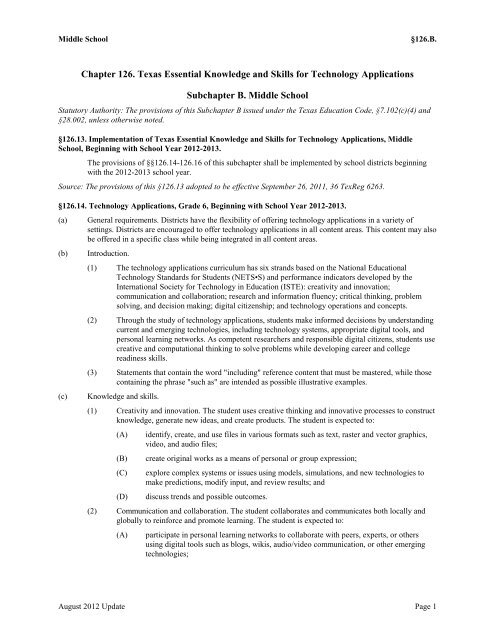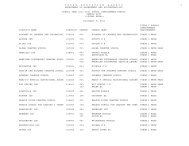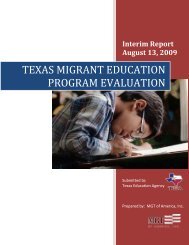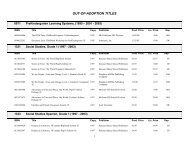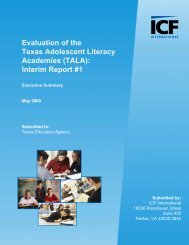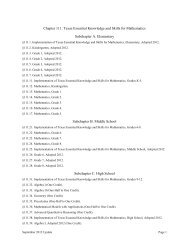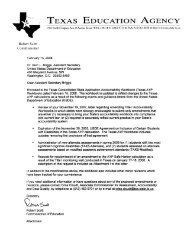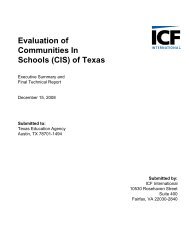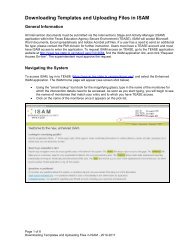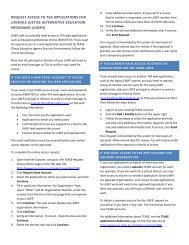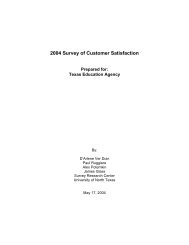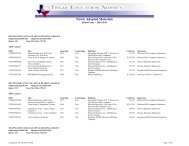Chapter 126. Texas Essential Knowledge and Skills for Technology
Chapter 126. Texas Essential Knowledge and Skills for Technology
Chapter 126. Texas Essential Knowledge and Skills for Technology
You also want an ePaper? Increase the reach of your titles
YUMPU automatically turns print PDFs into web optimized ePapers that Google loves.
Middle School<br />
§<strong>126.</strong>B.<br />
<strong>Chapter</strong> <strong>126.</strong> <strong>Texas</strong> <strong>Essential</strong> <strong>Knowledge</strong> <strong>and</strong> <strong>Skills</strong> <strong>for</strong> <strong>Technology</strong> Applications<br />
Subchapter B. Middle School<br />
Statutory Authority: The provisions of this Subchapter B issued under the <strong>Texas</strong> Education Code, §7.102(c)(4) <strong>and</strong><br />
§28.002, unless otherwise noted.<br />
§<strong>126.</strong>13. Implementation of <strong>Texas</strong> <strong>Essential</strong> <strong>Knowledge</strong> <strong>and</strong> <strong>Skills</strong> <strong>for</strong> <strong>Technology</strong> Applications, Middle<br />
School, Beginning with School Year 2012-2013.<br />
The provisions of §§<strong>126.</strong>14-<strong>126.</strong>16 of this subchapter shall be implemented by school districts beginning<br />
with the 2012-2013 school year.<br />
Source: The provisions of this §<strong>126.</strong>13 adopted to be effective September 26, 2011, 36 TexReg 6263.<br />
§<strong>126.</strong>14. <strong>Technology</strong> Applications, Grade 6, Beginning with School Year 2012-2013.<br />
(a)<br />
(b)<br />
(c)<br />
General requirements. Districts have the flexibility of offering technology applications in a variety of<br />
settings. Districts are encouraged to offer technology applications in all content areas. This content may also<br />
be offered in a specific class while being integrated in all content areas.<br />
Introduction.<br />
(1) The technology applications curriculum has six str<strong>and</strong>s based on the National Educational<br />
<strong>Technology</strong> St<strong>and</strong>ards <strong>for</strong> Students (NETS•S) <strong>and</strong> per<strong>for</strong>mance indicators developed by the<br />
International Society <strong>for</strong> <strong>Technology</strong> in Education (ISTE): creativity <strong>and</strong> innovation;<br />
communication <strong>and</strong> collaboration; research <strong>and</strong> in<strong>for</strong>mation fluency; critical thinking, problem<br />
solving, <strong>and</strong> decision making; digital citizenship; <strong>and</strong> technology operations <strong>and</strong> concepts.<br />
(2) Through the study of technology applications, students make in<strong>for</strong>med decisions by underst<strong>and</strong>ing<br />
current <strong>and</strong> emerging technologies, including technology systems, appropriate digital tools, <strong>and</strong><br />
personal learning networks. As competent researchers <strong>and</strong> responsible digital citizens, students use<br />
creative <strong>and</strong> computational thinking to solve problems while developing career <strong>and</strong> college<br />
readiness skills.<br />
(3) Statements that contain the word "including" reference content that must be mastered, while those<br />
containing the phrase "such as" are intended as possible illustrative examples.<br />
<strong>Knowledge</strong> <strong>and</strong> skills.<br />
(1) Creativity <strong>and</strong> innovation. The student uses creative thinking <strong>and</strong> innovative processes to construct<br />
knowledge, generate new ideas, <strong>and</strong> create products. The student is expected to:<br />
(A)<br />
(B)<br />
(C)<br />
(D)<br />
identify, create, <strong>and</strong> use files in various <strong>for</strong>mats such as text, raster <strong>and</strong> vector graphics,<br />
video, <strong>and</strong> audio files;<br />
create original works as a means of personal or group expression;<br />
explore complex systems or issues using models, simulations, <strong>and</strong> new technologies to<br />
make predictions, modify input, <strong>and</strong> review results; <strong>and</strong><br />
discuss trends <strong>and</strong> possible outcomes.<br />
(2) Communication <strong>and</strong> collaboration. The student collaborates <strong>and</strong> communicates both locally <strong>and</strong><br />
globally to rein<strong>for</strong>ce <strong>and</strong> promote learning. The student is expected to:<br />
(A)<br />
participate in personal learning networks to collaborate with peers, experts, or others<br />
using digital tools such as blogs, wikis, audio/video communication, or other emerging<br />
technologies;<br />
August 2012 Update Page 1
§<strong>126.</strong>B.<br />
Middle School<br />
(B)<br />
(C)<br />
communicate effectively with multiple audiences using a variety of media <strong>and</strong> <strong>for</strong>mats;<br />
<strong>and</strong><br />
read <strong>and</strong> discuss examples of technical writing.<br />
(3) Research <strong>and</strong> in<strong>for</strong>mation fluency. The student acquires, analyzes, <strong>and</strong> manages content from<br />
digital resources. The student is expected to:<br />
(A)<br />
(B)<br />
(C)<br />
(D)<br />
create a research plan to guide inquiry;<br />
discuss <strong>and</strong> use various search strategies, including keyword(s) <strong>and</strong> Boolean operators;<br />
select <strong>and</strong> evaluate various types of digital resources <strong>for</strong> accuracy <strong>and</strong> validity; <strong>and</strong><br />
process data <strong>and</strong> communicate results.<br />
(4) Critical thinking, problem solving, <strong>and</strong> decision making. The student makes in<strong>for</strong>med decisions by<br />
applying critical-thinking <strong>and</strong> problem-solving skills. The student is expected to:<br />
(A)<br />
(B)<br />
(C)<br />
(D)<br />
(E)<br />
(F)<br />
identify <strong>and</strong> define relevant problems <strong>and</strong> significant questions <strong>for</strong> investigation;<br />
plan <strong>and</strong> manage activities to develop a solution, design a computer program, or complete<br />
a project;<br />
collect <strong>and</strong> analyze data to identify solutions <strong>and</strong> make in<strong>for</strong>med decisions;<br />
use multiple processes <strong>and</strong> diverse perspectives to explore alternative solutions;<br />
make in<strong>for</strong>med decisions <strong>and</strong> support reasoning; <strong>and</strong><br />
transfer current knowledge to the learning of newly encountered technologies.<br />
(5) Digital citizenship. The student practices safe, responsible, legal, <strong>and</strong> ethical behavior while using<br />
technology tools <strong>and</strong> resources. The student is expected to:<br />
(A)<br />
(B)<br />
(C)<br />
(D)<br />
underst<strong>and</strong> copyright principles, including current laws, fair use guidelines, creative<br />
commons, open source, <strong>and</strong> public domain;<br />
practice ethical acquisition of in<strong>for</strong>mation <strong>and</strong> st<strong>and</strong>ard methods <strong>for</strong> citing sources;<br />
practice safe <strong>and</strong> appropriate online behavior, personal security guidelines, digital<br />
identity, digital etiquette, <strong>and</strong> acceptable use of technology; <strong>and</strong><br />
underst<strong>and</strong> the negative impact of inappropriate technology use, including online bullying<br />
<strong>and</strong> harassment, hacking, intentional virus setting, invasion of privacy, <strong>and</strong> piracy such as<br />
software, music, video, <strong>and</strong> other media.<br />
(6) <strong>Technology</strong> operations <strong>and</strong> concepts. The student demonstrates a thorough underst<strong>and</strong>ing of<br />
technology concepts, systems, <strong>and</strong> operations. The student is expected to:<br />
(A)<br />
(B)<br />
(C)<br />
(D)<br />
(E)<br />
(F)<br />
define <strong>and</strong> use current technology terminology appropriately;<br />
select technology tools based on licensing, application, <strong>and</strong> support;<br />
identify, underst<strong>and</strong>, <strong>and</strong> use operating systems;<br />
underst<strong>and</strong> <strong>and</strong> use software applications, including selecting <strong>and</strong> using software <strong>for</strong> a<br />
defined task;<br />
identify, underst<strong>and</strong>, <strong>and</strong> use hardware systems;<br />
underst<strong>and</strong> troubleshooting techniques such as restarting systems, checking power issues,<br />
resolving software compatibility, verifying network connectivity, connecting to remote<br />
resources, <strong>and</strong> modifying display properties;<br />
Page 2<br />
August 2012 Update
Middle School<br />
§<strong>126.</strong>B.<br />
(G)<br />
(H)<br />
(I)<br />
(J)<br />
(K)<br />
(L)<br />
(M)<br />
(N)<br />
demonstrate effective file management strategies such as file naming conventions,<br />
location, backup, hierarchy, folder structure, file conversion, tags, labels, <strong>and</strong> emerging<br />
digital organizational strategies;<br />
discuss how changes in technology throughout history have impacted various areas of<br />
study;<br />
discuss the relevance of technology as it applies to college <strong>and</strong> career readiness, life-long<br />
learning, <strong>and</strong> daily living;<br />
use a variety of local <strong>and</strong> remote input sources;<br />
use keyboarding techniques <strong>and</strong> ergonomic strategies while building speed <strong>and</strong> accuracy;<br />
create <strong>and</strong> edit files with productivity tools, including:<br />
(i)<br />
(ii)<br />
(iii)<br />
(iv)<br />
a word processing document using digital typography st<strong>and</strong>ards such as page<br />
layout, font <strong>for</strong>matting, paragraph <strong>for</strong>matting, <strong>and</strong> list attributes;<br />
a spreadsheet workbook using basic computational <strong>and</strong> graphic components such<br />
as basic <strong>for</strong>mulas <strong>and</strong> functions, data types, <strong>and</strong> chart generation;<br />
a database by manipulating components such as entering <strong>and</strong> searching <strong>for</strong><br />
relevant data; <strong>and</strong><br />
a digital publication using relevant publication st<strong>and</strong>ards;<br />
plan <strong>and</strong> create non-linear media projects using graphic design principles; <strong>and</strong><br />
integrate two or more technology tools to create a new digital product.<br />
Source: The provisions of this §<strong>126.</strong>14 adopted to be effective September 26, 2011, 36 TexReg 6263.<br />
§<strong>126.</strong>15. <strong>Technology</strong> Applications, Grade 7, Beginning with School Year 2012-2013.<br />
(a)<br />
(b)<br />
(c)<br />
General requirements. Districts have the flexibility of offering technology applications in a variety of<br />
settings. Districts are encouraged to offer technology applications in all content areas. This content may also<br />
be offered in a specific class while being integrated in all content areas.<br />
Introduction.<br />
(1) The technology applications curriculum has six str<strong>and</strong>s based on the National Educational<br />
<strong>Technology</strong> St<strong>and</strong>ards <strong>for</strong> Students (NETS•S) <strong>and</strong> per<strong>for</strong>mance indicators developed by the<br />
International Society <strong>for</strong> <strong>Technology</strong> in Education (ISTE): creativity <strong>and</strong> innovation;<br />
communication <strong>and</strong> collaboration; research <strong>and</strong> in<strong>for</strong>mation fluency; critical thinking, problem<br />
solving, <strong>and</strong> decision making; digital citizenship; <strong>and</strong> technology operations <strong>and</strong> concepts.<br />
(2) Through the study of technology applications, students make in<strong>for</strong>med decisions by underst<strong>and</strong>ing<br />
current <strong>and</strong> emerging technologies, including technology systems, appropriate digital tools, <strong>and</strong><br />
personal learning networks. As competent researchers <strong>and</strong> responsible digital citizens, students use<br />
creative <strong>and</strong> computational thinking to solve problems while developing career <strong>and</strong> college<br />
readiness skills.<br />
(3) Statements that contain the word "including" reference content that must be mastered, while those<br />
containing the phrase "such as" are intended as possible illustrative examples.<br />
<strong>Knowledge</strong> <strong>and</strong> skills.<br />
(1) Creativity <strong>and</strong> innovation. The student uses creative thinking <strong>and</strong> innovative processes to construct<br />
knowledge, generate new ideas, <strong>and</strong> create products. The student is expected to:<br />
(A)<br />
(B)<br />
identify, create, <strong>and</strong> use files in various <strong>for</strong>mats such as text, raster <strong>and</strong> vector graphics,<br />
video, <strong>and</strong> audio files;<br />
create <strong>and</strong> present original works as a means of personal or group expression;<br />
August 2012 Update Page 3
§<strong>126.</strong>B.<br />
Middle School<br />
(C)<br />
(D)<br />
explore complex systems or issues using models, simulations, <strong>and</strong> new technologies to<br />
make predictions, modify input, <strong>and</strong> review results; <strong>and</strong><br />
discuss trends <strong>and</strong> make predictions.<br />
(2) Communication <strong>and</strong> collaboration. The student collaborates <strong>and</strong> communicates both locally <strong>and</strong><br />
globally to rein<strong>for</strong>ce <strong>and</strong> promote learning. The student is expected to:<br />
(A)<br />
(B)<br />
(C)<br />
create personal learning networks to collaborate <strong>and</strong> publish with peers, experts, or others<br />
using digital tools such as blogs, wikis, audio/video communication, or other emerging<br />
technologies;<br />
communicate effectively with multiple audiences using a variety of media <strong>and</strong> <strong>for</strong>mats;<br />
<strong>and</strong><br />
create products using technical writing strategies.<br />
(3) Research <strong>and</strong> in<strong>for</strong>mation fluency. The student acquires, analyzes, <strong>and</strong> manages content from<br />
digital resources. The student is expected to:<br />
(A)<br />
(B)<br />
(C)<br />
(D)<br />
create a research plan to guide inquiry;<br />
use <strong>and</strong> evaluate various search strategies, including keyword(s) <strong>and</strong> Boolean operators;<br />
select <strong>and</strong> evaluate various types of digital resources <strong>for</strong> accuracy <strong>and</strong> validity; <strong>and</strong><br />
process data <strong>and</strong> communicate results.<br />
(4) Critical thinking, problem solving, <strong>and</strong> decision making. The student makes in<strong>for</strong>med decisions by<br />
applying critical-thinking <strong>and</strong> problem-solving skills. The student is expected to:<br />
(A)<br />
(B)<br />
(C)<br />
(D)<br />
(E)<br />
(F)<br />
identify <strong>and</strong> define relevant problems <strong>and</strong> significant questions <strong>for</strong> investigation;<br />
plan <strong>and</strong> manage activities to develop a solution, design a computer program, or complete<br />
a project;<br />
collect <strong>and</strong> analyze data to identify solutions <strong>and</strong> make in<strong>for</strong>med decisions;<br />
use multiple processes <strong>and</strong> diverse perspectives to explore alternative solutions;<br />
make in<strong>for</strong>med decisions <strong>and</strong> support reasoning; <strong>and</strong><br />
transfer current knowledge to the learning of newly encountered technologies.<br />
(5) Digital citizenship. The student practices safe, responsible, legal, <strong>and</strong> ethical behavior while using<br />
technology tools <strong>and</strong> resources. The student is expected to:<br />
(A)<br />
(B)<br />
(C)<br />
(D)<br />
underst<strong>and</strong> <strong>and</strong> practice copyright principles, including current laws, fair use guidelines,<br />
creative commons, open source, <strong>and</strong> public domain;<br />
practice ethical acquisition of in<strong>for</strong>mation <strong>and</strong> st<strong>and</strong>ard methods <strong>for</strong> citing sources;<br />
practice <strong>and</strong> explain safe <strong>and</strong> appropriate online behavior, personal security guidelines,<br />
digital identity, digital etiquette, <strong>and</strong> acceptable use of technology; <strong>and</strong><br />
underst<strong>and</strong> the negative impact of inappropriate technology use, including online bullying<br />
<strong>and</strong> harassment, hacking, intentional virus setting, invasion of privacy, <strong>and</strong> piracy such as<br />
software, music, video, <strong>and</strong> other media.<br />
(6) <strong>Technology</strong> operations <strong>and</strong> concepts. The student demonstrates a thorough underst<strong>and</strong>ing of<br />
technology concepts, systems, <strong>and</strong> operations. The student is expected to:<br />
(A)<br />
(B)<br />
(C)<br />
define <strong>and</strong> use current technology terminology appropriately;<br />
select <strong>and</strong> apply technology tools based on licensing, application, <strong>and</strong> support;<br />
identify, underst<strong>and</strong>, <strong>and</strong> use operating systems;<br />
Page 4<br />
August 2012 Update
Middle School<br />
§<strong>126.</strong>B.<br />
(D)<br />
(E)<br />
(F)<br />
(G)<br />
(H)<br />
(I)<br />
(J)<br />
(K)<br />
(L)<br />
(M)<br />
(N)<br />
underst<strong>and</strong> <strong>and</strong> use software applications, including selecting <strong>and</strong> using software <strong>for</strong> a<br />
defined task;<br />
identify, underst<strong>and</strong>, <strong>and</strong> use hardware systems;<br />
underst<strong>and</strong> troubleshooting techniques such as restarting systems, checking power issues,<br />
resolving software compatibility, verifying network connectivity, connecting to remote<br />
resources, <strong>and</strong> modifying display properties;<br />
implement effective file management strategies such as file naming conventions, location,<br />
backup, hierarchy, folder structure, file conversion, tags, labels, <strong>and</strong> emerging digital<br />
organizational strategies;<br />
explain how changes in technology throughout history have impacted various areas of<br />
study;<br />
explain the relevance of technology as it applies to college <strong>and</strong> career readiness, life-long<br />
learning, <strong>and</strong> daily living;<br />
use a variety of local <strong>and</strong> remote input sources;<br />
use keyboarding techniques <strong>and</strong> ergonomic strategies while building speed <strong>and</strong> accuracy;<br />
create <strong>and</strong> edit files with productivity tools, including:<br />
(i)<br />
(ii)<br />
(iii)<br />
(iv)<br />
a word processing document using digital typography st<strong>and</strong>ards such as page<br />
layout, font <strong>for</strong>matting, paragraph <strong>for</strong>matting, <strong>and</strong> list attributes;<br />
a spreadsheet workbook using advanced computational <strong>and</strong> graphic components<br />
such as complex <strong>for</strong>mulas, basic functions, data types, <strong>and</strong> chart generation;<br />
a database by manipulating components such as defining fields, entering data,<br />
<strong>and</strong> designing layouts appropriate <strong>for</strong> reporting; <strong>and</strong><br />
a digital publication using relevant publication st<strong>and</strong>ards;<br />
plan <strong>and</strong> create non-linear media projects using graphic design principles; <strong>and</strong><br />
integrate two or more technology tools to create a new digital product.<br />
Source: The provisions of this §<strong>126.</strong>15 adopted to be effective September 26, 2011, 36 TexReg 6263.<br />
§<strong>126.</strong>16. <strong>Technology</strong> Applications, Grade 8, Beginning with School Year 2012-2013.<br />
(a)<br />
(b)<br />
General requirements. Districts have the flexibility of offering technology applications in a variety of<br />
settings. Districts are encouraged to offer technology applications in all content areas. This content may also<br />
be offered in a specific class while being integrated in all content areas.<br />
Introduction.<br />
(1) The technology applications curriculum has six str<strong>and</strong>s based on the National Educational<br />
<strong>Technology</strong> St<strong>and</strong>ards <strong>for</strong> Students (NETS•S) <strong>and</strong> per<strong>for</strong>mance indicators developed by the<br />
International Society <strong>for</strong> <strong>Technology</strong> in Education (ISTE): creativity <strong>and</strong> innovation;<br />
communication <strong>and</strong> collaboration; research <strong>and</strong> in<strong>for</strong>mation fluency; critical thinking, problem<br />
solving, <strong>and</strong> decision making; digital citizenship; <strong>and</strong> technology operations <strong>and</strong> concepts.<br />
(2) Through the study of technology applications, students make in<strong>for</strong>med decisions by underst<strong>and</strong>ing<br />
current <strong>and</strong> emerging technologies, including technology systems, appropriate digital tools, <strong>and</strong><br />
personal learning networks. As competent researchers <strong>and</strong> responsible digital citizens, students use<br />
creative <strong>and</strong> computational thinking to solve problems while developing career <strong>and</strong> college<br />
readiness skills.<br />
(3) Statements that contain the word "including" reference content that must be mastered, while those<br />
containing the phrase "such as" are intended as possible illustrative examples.<br />
August 2012 Update Page 5
§<strong>126.</strong>B.<br />
Middle School<br />
(c)<br />
<strong>Knowledge</strong> <strong>and</strong> skills.<br />
(1) Creativity <strong>and</strong> innovation. The student uses creative thinking <strong>and</strong> innovative processes to construct<br />
knowledge, generate new ideas, <strong>and</strong> create products. The student is expected to:<br />
(A)<br />
(B)<br />
(C)<br />
(D)<br />
identify, create, <strong>and</strong> use files in various <strong>for</strong>mats, including text, raster <strong>and</strong> vector graphics,<br />
video, <strong>and</strong> audio files;<br />
create, present, <strong>and</strong> publish original works as a means of personal or group expression;<br />
explore complex systems or issues using models, simulations, <strong>and</strong> new technologies to<br />
develop hypotheses, modify input, <strong>and</strong> analyze results; <strong>and</strong><br />
analyze trends <strong>and</strong> <strong>for</strong>ecast possibilities.<br />
(2) Communication <strong>and</strong> collaboration. The student collaborates <strong>and</strong> communicates both locally <strong>and</strong><br />
globally to rein<strong>for</strong>ce <strong>and</strong> promote learning. The student is expected to:<br />
(A)<br />
(B)<br />
(C)<br />
create <strong>and</strong> manage personal learning networks to collaborate <strong>and</strong> publish with peers,<br />
experts, or others using digital tools such as blogs, wikis, audio/video communication, or<br />
other emerging technologies;<br />
communicate effectively with multiple audiences using a variety of media <strong>and</strong> <strong>for</strong>mats;<br />
<strong>and</strong><br />
create <strong>and</strong> publish products using technical writing strategies.<br />
(3) Research <strong>and</strong> in<strong>for</strong>mation fluency. The student acquires, analyzes, <strong>and</strong> manages content from<br />
digital resources. The student is expected to:<br />
(A)<br />
(B)<br />
(C)<br />
(D)<br />
create a research plan to guide inquiry;<br />
plan, use, <strong>and</strong> evaluate various search strategies, including keyword(s) <strong>and</strong> Boolean<br />
operators;<br />
select <strong>and</strong> evaluate various types of digital resources <strong>for</strong> accuracy <strong>and</strong> validity; <strong>and</strong><br />
process data <strong>and</strong> communicate results.<br />
(4) Critical thinking, problem solving, <strong>and</strong> decision making. The student makes in<strong>for</strong>med decisions by<br />
applying critical-thinking <strong>and</strong> problem-solving skills. The student is expected to:<br />
(A)<br />
(B)<br />
(C)<br />
(D)<br />
(E)<br />
(F)<br />
identify <strong>and</strong> define relevant problems <strong>and</strong> significant questions <strong>for</strong> investigation;<br />
plan <strong>and</strong> manage activities to develop a solution, design a computer program, or complete<br />
a project;<br />
collect <strong>and</strong> analyze data to identify solutions <strong>and</strong> make in<strong>for</strong>med decisions;<br />
use multiple processes <strong>and</strong> diverse perspectives to explore alternative solutions;<br />
make in<strong>for</strong>med decisions <strong>and</strong> support reasoning; <strong>and</strong><br />
transfer current knowledge to the learning of newly encountered technologies.<br />
(5) Digital citizenship. The student practices safe, responsible, legal, <strong>and</strong> ethical behavior while using<br />
technology tools <strong>and</strong> resources. The student is expected to:<br />
(A)<br />
(B)<br />
(C)<br />
underst<strong>and</strong>, explain, <strong>and</strong> practice copyright principles, including current laws, fair use<br />
guidelines, creative commons, open source, <strong>and</strong> public domain;<br />
practice <strong>and</strong> explain ethical acquisition of in<strong>for</strong>mation <strong>and</strong> st<strong>and</strong>ard methods <strong>for</strong> citing<br />
sources;<br />
practice <strong>and</strong> explain safe <strong>and</strong> appropriate online behavior, personal security guidelines,<br />
digital identity, digital etiquette, <strong>and</strong> acceptable use of technology; <strong>and</strong><br />
Page 6<br />
August 2012 Update
Middle School<br />
§<strong>126.</strong>B.<br />
(D)<br />
underst<strong>and</strong> <strong>and</strong> explain the negative impact of inappropriate technology use, including<br />
online bullying <strong>and</strong> harassment, hacking, intentional virus setting, invasion of privacy,<br />
<strong>and</strong> piracy such as software, music, video, <strong>and</strong> other media.<br />
(6) <strong>Technology</strong> operations <strong>and</strong> concepts. The student demonstrates a thorough underst<strong>and</strong>ing of<br />
technology concepts, systems, <strong>and</strong> operations. The student is expected to:<br />
(A)<br />
(B)<br />
(C)<br />
(D)<br />
(E)<br />
(F)<br />
(G)<br />
(H)<br />
(I)<br />
(J)<br />
(K)<br />
(L)<br />
(M)<br />
(N)<br />
define <strong>and</strong> use current technology terminology appropriately;<br />
evaluate <strong>and</strong> select technology tools based on licensing, application, <strong>and</strong> support;<br />
identify, underst<strong>and</strong>, <strong>and</strong> use operating systems;<br />
underst<strong>and</strong> <strong>and</strong> use software applications, including selecting <strong>and</strong> using software <strong>for</strong> a<br />
defined task;<br />
identify, underst<strong>and</strong>, <strong>and</strong> use hardware systems;<br />
apply troubleshooting techniques, including restarting systems, checking power issues,<br />
resolving software compatibility, verifying network connectivity, connecting to remote<br />
resources, <strong>and</strong> modifying display properties;<br />
implement effective file management strategies such as file naming conventions, location,<br />
backup, hierarchy, folder structure, file conversion, tags, labels, <strong>and</strong> emerging digital<br />
organizational strategies;<br />
evaluate how changes in technology throughout history have impacted various areas of<br />
study;<br />
evaluate the relevance of technology as it applies to college <strong>and</strong> career readiness, life-long<br />
learning, <strong>and</strong> daily living;<br />
use a variety of local <strong>and</strong> remote input sources;<br />
use keyboarding techniques <strong>and</strong> ergonomic strategies while building speed <strong>and</strong> accuracy;<br />
create <strong>and</strong> edit files with productivity tools, including:<br />
(i) a word processing document using digital typography st<strong>and</strong>ards such as page<br />
layout, font <strong>for</strong>matting, paragraph <strong>for</strong>matting, mail merge, <strong>and</strong> list attributes;<br />
(ii)<br />
(iii)<br />
(iv)<br />
a spreadsheet workbook using advanced computational <strong>and</strong> graphic components<br />
such as complex <strong>for</strong>mulas, advanced functions, data types, <strong>and</strong> chart generation;<br />
a database by manipulating components, including defining fields, entering data,<br />
<strong>and</strong> designing layouts appropriate <strong>for</strong> reporting; <strong>and</strong><br />
a digital publication using relevant publication st<strong>and</strong>ards <strong>and</strong> graphic design<br />
principles;<br />
plan <strong>and</strong> create non-linear media projects using graphic design principles; <strong>and</strong><br />
integrate two or more technology tools to create a new digital product.<br />
Source: The provisions of this §<strong>126.</strong>16 adopted to be effective September 26, 2011, 36 TexReg 6263.<br />
August 2012 Update Page 7


